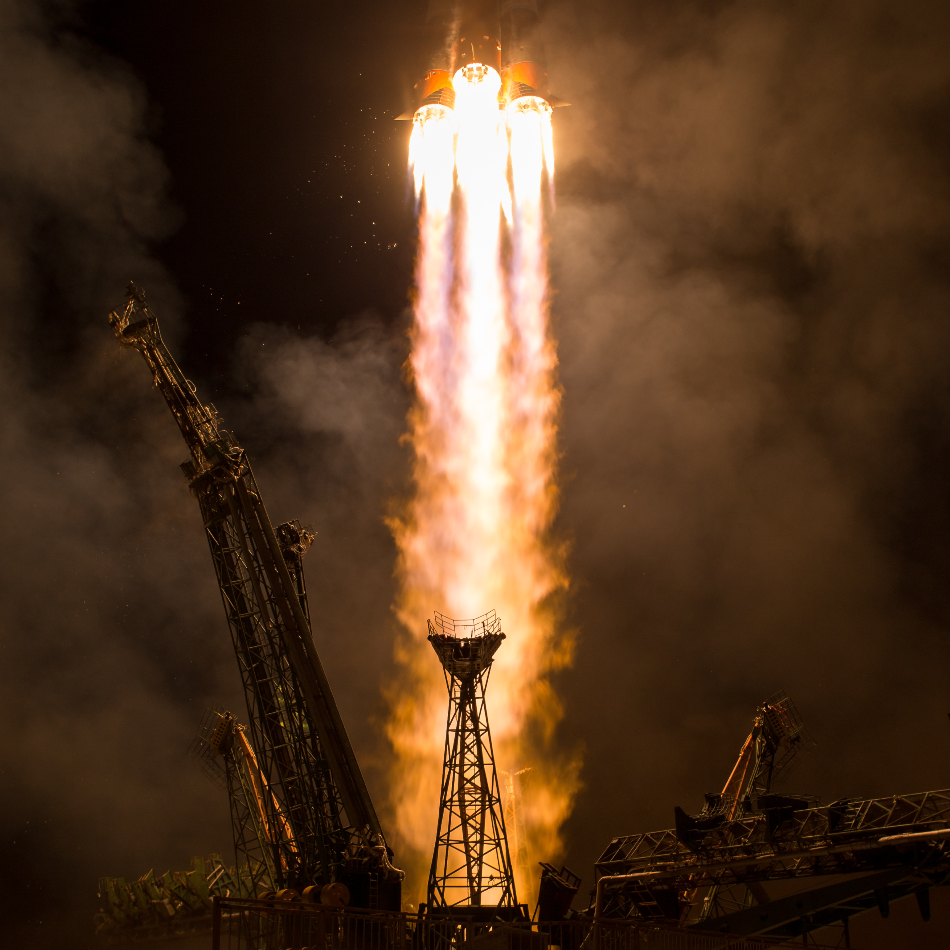Feb 19 2020
Plenty of fuel is required to launch anything into space. In fact, over 3.5 million pounds of fuel is required to send NASA’s Space Shuttle into orbit, and this fuel is approximately 15 times heavier than a blue whale.
 A Soyuz spacecraft launches from the Baikonur Cosmodrome in Kazakhstan in 2017 using a conventional, fuel-intensive engine. UW researchers have developed a mathematical model that describes how a new type of engine—one that promises to make rockets fuel-efficient, more lightweight and less complicated to construct—works. Image Credit: NASA/Bill Ingalls/Flickr.
A Soyuz spacecraft launches from the Baikonur Cosmodrome in Kazakhstan in 2017 using a conventional, fuel-intensive engine. UW researchers have developed a mathematical model that describes how a new type of engine—one that promises to make rockets fuel-efficient, more lightweight and less complicated to construct—works. Image Credit: NASA/Bill Ingalls/Flickr.
However, a novel type of engine—referred to as a rotating detonation engine—has the potential to make rockets more fuel-efficient and also more lightweight and less challenging to build. But there is just one problem—currently, the rotating detonation engine is highly unreliable to be used in a real rocket.
At the University of Washington, scientists have devised a unique mathematical model that elucidates the operation of these novel engines. Armed with this data, engineers can device tests to enhance the rotating detonation engines and render them more stable, for the first time. The researchers published these findings in the Physical Review E journal on January 10th, 2020.
The rotating detonation engine field is still in its infancy. We have tons of data about these engines, but we don’t understand what is going on. I tried to recast our results by looking at pattern formations instead of asking an engineering question—such as how to get the highest performing engine—and then boom, it turned out that it works.
James Koch, Study Lead Author and Doctoral Student, Department of Aeronautics and Astronautics, University of Washington
A standard rocket engine operates by first burning propellant and subsequently forcing it out of the rear of the engine to produce thrust.
“A rotating detonation engine takes a different approach to how it combusts propellant,” added Koch. “It’s made of concentric cylinders. Propellant flows in the gap between the cylinders, and, after ignition, the rapid heat release forms a shock wave, a strong pulse of gas with significantly higher pressure and temperature that is moving faster than the speed of sound.
Koch continued, “This combustion process is literally a detonation—an explosion—but behind this initial start-up phase, we see a number of stable combustion pulses form that continue to consume available propellant. This produces high pressure and temperature that drives exhaust out the back of the engine at high speeds, which can generate thrust.”
Traditional engines utilize a great deal of machinery to guide and regulate the combustion reaction so that it produces the work required to propel the engine. However, the shock wave in a rotating detonation engine naturally performs everything without requiring any further assistance from engine components.
The combustion-driven shocks naturally compress the flow as they travel around the combustion chamber. The downside of that is that these detonations have a mind of their own. Once you detonate something, it just goes. It’s so violent.
James Koch, Study Lead Author and Doctoral Student, Department of Aeronautics and Astronautics, University of Washington
In an attempt to elucidate the workings of these engines, the scientists initially created an experimental rotating detonation engine in which they can manage varying parameters such as the size of the gap that exists between the cylinders. Then, using a high-speed camera, the researchers recorded the combustion processes.
It took just 0.5 seconds to complete each experiment but the scientists recorded these experiments at 240,000 frames per second so that they can observe what exactly was occurring in slow motion. And from there, the team created a mathematical model to imitate what they visualized in the videos.
This is the only model in the literature currently capable of describing the diverse and complex dynamics of these rotating detonation engines that we observe in experiments.
J. Nathan Kutz, Study Co-Author and Professor, Department of Applied Mathematics, University of Washington
For the first time, the mathematical model enabled the scientists to establish whether this type of engine would be unstable or stable. This model also enabled the team to evaluate the actual performance of a particular engine.
“This new approach is different from conventional wisdom in the field, and its broad applications and new insights were a complete surprise to me,” stated Carl Knowlen, the study’s co-author and a research associate professor in aeronautics and astronautics at the University of Washington.
At present, the new model is not completely ready and hence cannot be used by engineers.
“My goal here was solely to reproduce the behavior of the pulses we saw—to make sure that the model output is similar to our experimental results,” added Koch. “I have identified the dominant physics and how they interplay. Now I can take what I’ve done here and make it quantitative. From there we can talk about how to make a better engine.”
Mitsuru Kurosaka, a professor of aeronautics and astronautics at the University of Washington is also the co-author of the study. The U.S. Air Force Office of Scientific Research and the Office of Naval Research funded the study.
To start the reaction, propellant flows in the gap between the cylinders, and, after ignition, the rapid heat release forms a shock wave (starts at 11 seconds). After this start-up phase, a number of stable combustion pulses form that continue to consume the available propellant. Video Credit: James Koch/University of Washington.